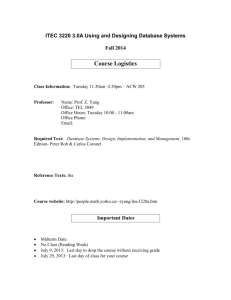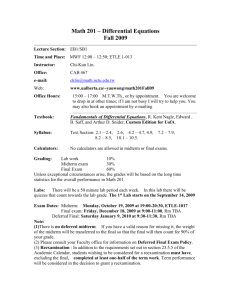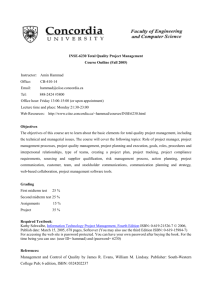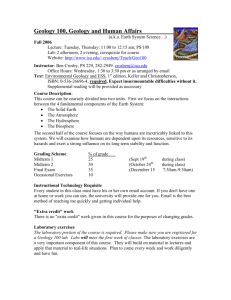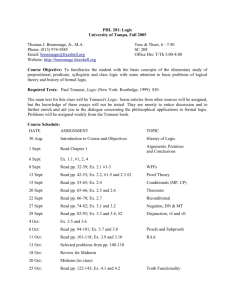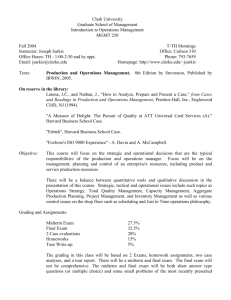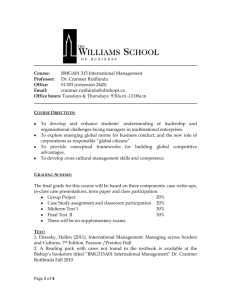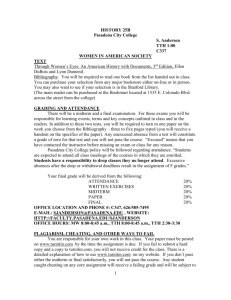Gender & Language Course Syllabus - Fall 2010
advertisement
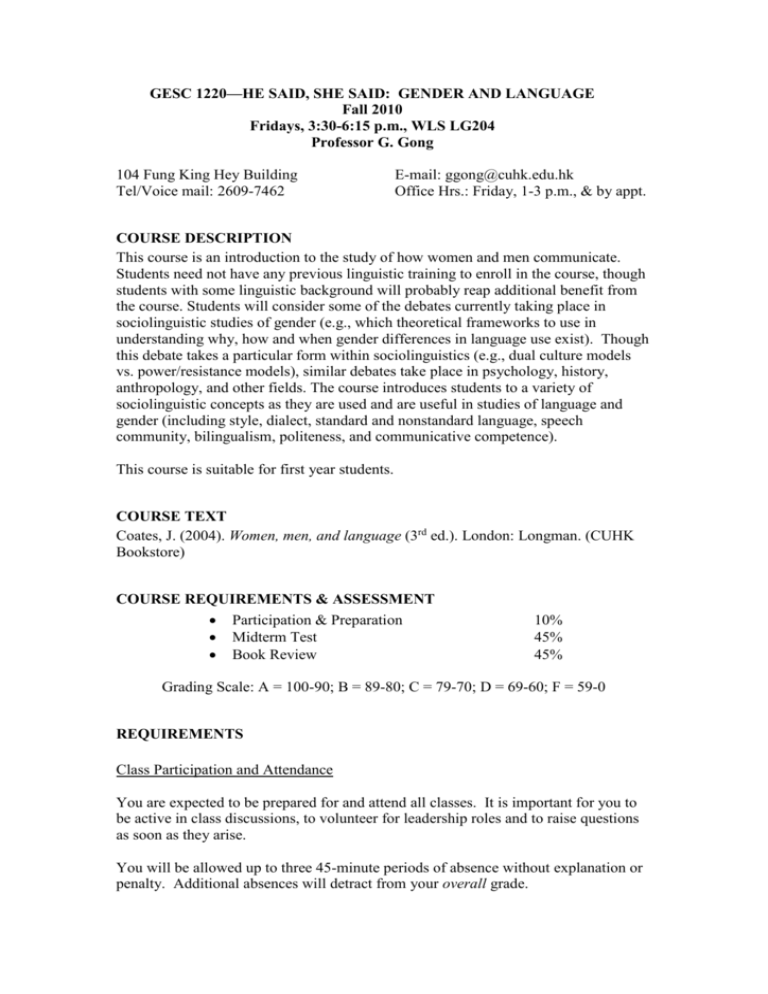
GESC 1220—HE SAID, SHE SAID: GENDER AND LANGUAGE Fall 2010 Fridays, 3:30-6:15 p.m., WLS LG204 Professor G. Gong 104 Fung King Hey Building Tel/Voice mail: 2609-7462 E-mail: ggong@cuhk.edu.hk Office Hrs.: Friday, 1-3 p.m., & by appt. COURSE DESCRIPTION This course is an introduction to the study of how women and men communicate. Students need not have any previous linguistic training to enroll in the course, though students with some linguistic background will probably reap additional benefit from the course. Students will consider some of the debates currently taking place in sociolinguistic studies of gender (e.g., which theoretical frameworks to use in understanding why, how and when gender differences in language use exist). Though this debate takes a particular form within sociolinguistics (e.g., dual culture models vs. power/resistance models), similar debates take place in psychology, history, anthropology, and other fields. The course introduces students to a variety of sociolinguistic concepts as they are used and are useful in studies of language and gender (including style, dialect, standard and nonstandard language, speech community, bilingualism, politeness, and communicative competence). This course is suitable for first year students. COURSE TEXT Coates, J. (2004). Women, men, and language (3rd ed.). London: Longman. (CUHK Bookstore) COURSE REQUIREMENTS & ASSESSMENT Participation & Preparation Midterm Test Book Review 10% 45% 45% Grading Scale: A = 100-90; B = 89-80; C = 79-70; D = 69-60; F = 59-0 REQUIREMENTS Class Participation and Attendance You are expected to be prepared for and attend all classes. It is important for you to be active in class discussions, to volunteer for leadership roles and to raise questions as soon as they arise. You will be allowed up to three 45-minute periods of absence without explanation or penalty. Additional absences will detract from your overall grade. Midterm Test The midterm test will give you an opportunity to review the major topics that have been covered in the course at this point in the semester. Book Review You will write a review of a book that explores gender and language. You will be asked to submit a list of book choices for approval. GESC 1220—HE SAID, SHE SAID: GENDER AND LANGUAGE WEEK/DATE 1/Sept. 10 2/Sept. 17 3/Sept. 24 4/Oct. 1 5/Oct. 8 6/Oct. 15 7/Oct. 22 8/Oct. 29 9/Nov. 5 10/Nov. 12 11/Nov. 19 12/Nov. 26 13/Dec. 3 CLASS PREPARATION: READING/HOMEWORK/TASKS Introduction to the course: requirements and syllabus. Chapter 1, “Language and Gender,” pp. 3-8. Chapter 2, “The historical background (I)—Folklinguistics and the early grammarians,” pp. 9-27. Chapter 3, “The historical background (II)—Anthropologists and dialectologists,” pp. 28-44. Chapter 4, “Quantitative studies,” pp. 47-69. Chapter 5, “Social networks,” pp. 70-84. NATIONAL DAY HOLIDAY. Chapter 6, “Gender differences in conversational practice,” pp. 85-110. Video: Schrank, L. W. (1994). Gender and communication. She talks: He talks. Lake Zurich, IL: The Learning Seed. *Midterm Test. Sexism in language use. Video: Lovdal, L. T. (1995). Sexism in language: Thief of honor, shaper of lies. Berkeley, CA: UC Extension Center for Media & Independent Learning. Chapter 7, “Conversational dominance in mixed talk,” pp. 111-124. Video: Tannen, D. (1995). Talking 9 to 5: Women and men in the workplace. Burnsville, MN: ChartHouse International Learning Corporation. Chapter 8, “Same-sex talk,” pp. 125-144. Chapter 9: “Children and gender-differentiated language, “ pp. 147-170. Chapter 10: “The role of gender differences in linguistic change,” pp. 171188. *Book review due in class. Chapter 11, “The social consequences of gender differences in language,” pp. 189-211. Video: Yang, Yue-qing. (1999). Nu Shu. Vancouver, B.C.: East-West Film Enterprise Ltd., Moving Images Distribution. Chapter 12, “New developments in language and gender research,” pp. 215-221. Last class day.
